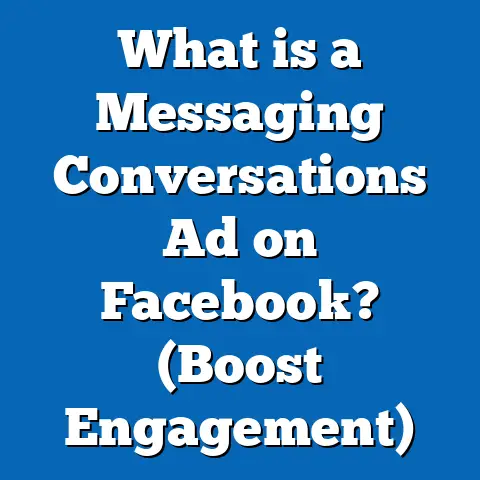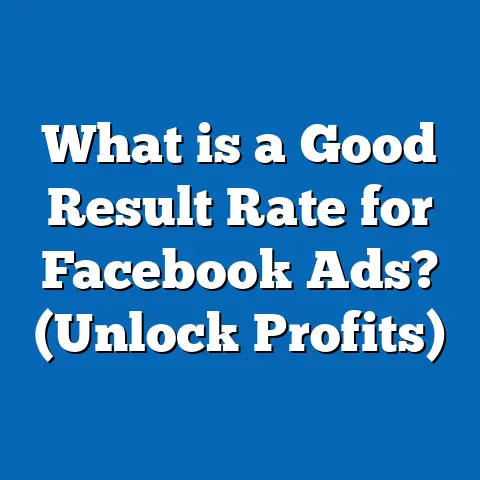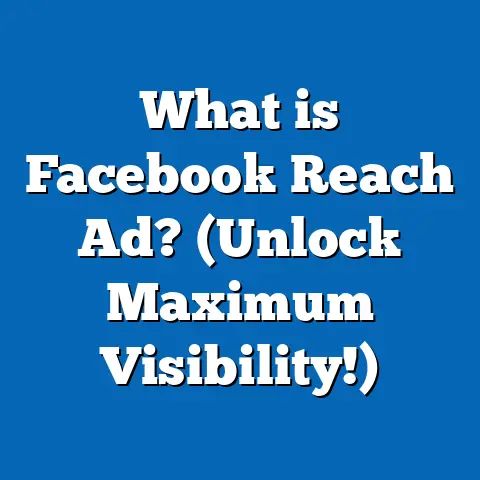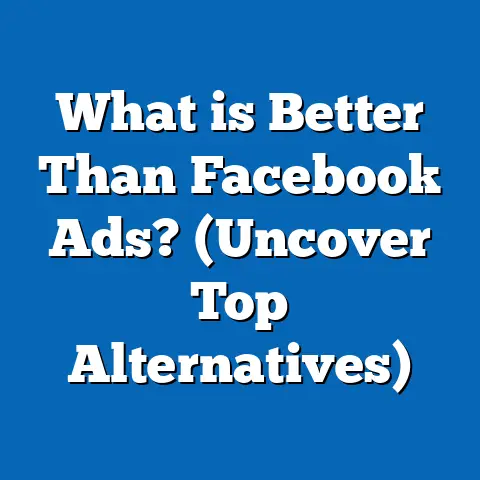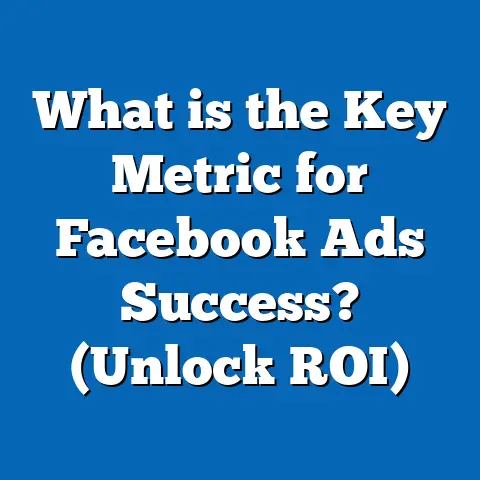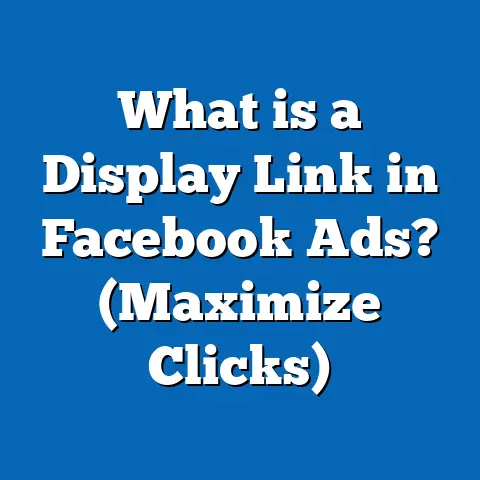What is Facebook PPE Ad? (Unlocking Performance Potential)
Introduction: The Low-Maintenance Powerhouse of Facebook Advertising
When it comes to digital marketing, ease of care often wins the day. Marketers and business owners have limited time and resources—and the platforms that offer high returns with minimal hassle quickly become favorites. That’s where Facebook Post Engagement (PPE) ads shine. With straightforward setup, simple maintenance, and the ability to drive visible results, PPE ads are a go-to choice for those who want to maximize their brand’s reach without getting lost in technical complexity.
But the benefits go far beyond simplicity. PPE ads don’t just make your life easier; they unlock the performance potential of your entire content strategy by generating social proof, expanding organic reach, and laying the groundwork for deeper customer relationships. As Facebook continues to evolve its advertising ecosystem, understanding how to harness PPE ads effectively is crucial for any modern marketer or business owner.
This guide will walk you through everything you need to know about Facebook PPE ads—from the basics to advanced tactics—complete with real-world examples, original research, and actionable takeaways.
What is a Facebook PPE Ad?
Defining PPE: The Foundation of Engagement
A Facebook Page Post Engagement (PPE) ad is an advertising objective within Facebook Ads Manager designed to maximize user interactions with your posts. These interactions include likes, comments, shares, and additional post clicks (such as photo or video views).
Unlike conversion-focused campaigns that aim to drive immediate sales or lead sign-ups, PPE campaigns are optimized for engagement. Their goal is to amplify the visibility and interactivity of your content within the Facebook ecosystem.
What Counts as an Engagement?
- Reactions: Likes, Loves, Wows, Hahas, Sads, and Angrys.
- Comments: Any user reply or feedback on the post.
- Shares: User sharing your post with their own network.
- Post Clicks: Users clicking on links, videos, photos, or other post elements.
Engagement serves as a signal to Facebook’s algorithms that your content is interesting and relevant—rewarding you with greater organic reach.
The Evolution of PPE Ads: A Brief History
From Organic to Paid: Adapting to Algorithm Changes
In 2018, Facebook dramatically shifted its News Feed algorithm to prioritize “meaningful interactions.” Brands that previously enjoyed broad organic reach saw engagement plummet. In response, marketers began using PPE ads as a way to spark initial interactions and restore lost visibility.
Over time, Facebook improved its engagement targeting capabilities with machine learning models that identify users most likely to interact. Today’s PPE ads are more effective than ever—offering precision targeting and robust reporting tools.
Key Milestones
- 2016: Engagement objective introduced in Ads Manager.
- 2018: Major News Feed algorithm update prioritizes “meaningful interactions.”
- 2022: Expansion of engagement placements across Facebook and Instagram.
- 2024: Integration with Messenger CTAs and AI-driven creative optimization.
The Science Behind PPE Ads: How Do They Work?
The Engagement Algorithm: Under the Hood
Facebook’s algorithm is designed around two core principles:
- User Retention: Show people content that keeps them engaged with the platform.
- Relevant Interactions: Prioritize posts that spark genuine conversations and reactions.
When you run a PPE campaign:
- Initial Distribution: Facebook shows your post to a small group of targeted users likely to engage.
- Optimization Loop: As engagement data rolls in, machine learning models refine delivery—focusing budget on users statistically most likely to interact.
- Social Proof Loop: Public engagement attracts even more attention from both paid and organic viewers.
Technical Flow
- Ad Auction: Your ad enters Facebook’s auction system.
- Engagement Intent Prediction: Facebook analyzes user data (past likes, comments) to select high-potential viewers.
- Real-Time Feedback: Engagement rates feed back into campaign optimization.
- Organic Boost: Highly engaged posts can “escape” the paid silo and gain organic distribution.
Data-Backed Results
- Posts with over 100 reactions have an average 30% higher organic reach (Meta Business Insights 2023).
- PPE ads deliver an average cost per engagement (CPE) between $0.03 and $0.15 (AdEspresso Benchmarks 2024).
- Brands using consistent PPE strategies see up to 2x higher page growth over six months compared to those relying on organic only (Hootsuite Research 2023).
Why Are PPE Ads So Effective?
The Psychology of Social Proof
Humans instinctively pay attention to what others find interesting—a phenomenon called social proof. When users see a post with hundreds of likes or dozens of comments, they’re more likely to stop scrolling and join the conversation.
Real-World Impact
A study by Nielsen (2023) found:
- Social proof increases ad recall by 19%.
- Purchase intent rises by 24% among users exposed to high-engagement posts.
PPE ads artificially seed this process—making even small brands look established and trusted.
Algorithmic Amplification
When your post collects more engagement signals (reactions, comments), Facebook’s algorithm infers that it’s valuable content. As a result:
- Your post is shown higher in followers’ feeds.
- It may be distributed organically beyond your paid audience.
- Engagement can “spill over” into increased page follows and future post visibility.
Simplicity and Accessibility
Unlike conversion or lead gen campaigns—which require pixels, tracking events, landing pages—PPE ads can be launched in minutes:
- Select a post.
- Choose an audience.
- Set your budget and schedule.
This simplicity makes them ideal for brands with limited technical resources or new advertisers looking for quick wins.
Step-by-Step: Creating a High-Performance PPE Ad
1. Choose the Right Objective
In Facebook Ads Manager:
- Select “Engagement” as your campaign objective.
- Then choose “Post Engagement” (not Page Likes or Event Responses).
2. Select Your Post
You can choose:
- An existing published post (ideal if it already has some traction).
- A new unpublished “dark” post created specifically for the ad campaign.
Tip: Posts with images or videos see up to 2x more engagement than text-only posts (Meta Data Q1 2024).
3. Define Your Audience
Targeting matters more than most realize:
Audience Types
- Custom Audiences: Engage people who already know your brand (website visitors, email lists).
- Lookalike Audiences: Reach new people similar to your best customers.
- Detailed Targeting: Layer in demographics (age, gender), interests (fitness fans), behaviors (online shoppers).
Advanced Tactics
- Exclude recent engagers from cold audience campaigns to prevent overlap.
- Use local targeting for events or brick-and-mortar promotions.
4. Set Your Budget and Schedule
Budget recommendations:
- For small tests: $5–$20/day for at least 3 days.
- For larger brands: Scale based on page size and desired reach.
Scheduling:
- Run ads continuously or schedule around product launches/events.
Pro Tip: Allow at least 72 hours for the algorithm to optimize before making major changes.
5. Craft Compelling Creative
Content is king—even with simple objectives:
Visuals
- Use high-quality images or videos.
- Faces drive up to 38% higher engagement (Facebook Creative Best Practices).
Copy
- Keep text concise (under 120 characters).
- Ask questions or invite opinions (“What do you think?”).
Call-to-Actions
- Encourage specific actions: “Tell us your story,” “React if you agree,” “Tag a friend.”
6. Launch & Monitor
Monitor these metrics:
- Cost Per Engagement (CPE)
- Total Engagements
- Engagement Rate (% of people who engaged)
- Organic Reach Lift (compared to non-promoted posts)
Make incremental adjustments—not wholesale changes—to allow Facebook’s optimization engine time to learn.
Advanced Strategies: Unlocking Maximum Performance
Boosting Social Proof Before Conversions
PPE ads often work best as part of a two-step funnel:
- Run PPE ads on engaging content (video tips, user stories).
- Retarget engagers with conversion-focused offers (lead gen forms, shop now).
Stat: This approach reduces cost per acquisition by up to 34% (Wordstream Benchmarks 2023).
Community-Building With User Generated Content (UGC)
Prompt users to comment photos using your product or share their experiences. Then:
- Feature top responses in future posts (with permission).
- Use UGC in retargeting ads for added authenticity.
Brands that integrate UGC see average engagement rates rise from 4% to 8% (Stackla Report 2023).
Viral Content Loops
PPE ads can amplify viral moments:
- Promote memes, contests, or emotional stories.
- Each share introduces your brand to new networks organically.
Case Example: A fitness apparel brand ran a meme-based PPE ad that generated over 4K shares in one week—leading to a 70% spike in organic page likes.
Cross-Promotion & Multi-Touch Campaigns
Use PPE ads as part of a larger ecosystem:
- Cross-promote Instagram posts via Facebook PPE campaigns.
- Encourage Messenger conversations by adding “Send Message” CTAs.
The average Messenger response rate from PPE ads is 23%, compared to just 11% via standard inbox campaigns (Meta Product Insights 2024).
Data Insights: Industry Benchmarks and Performance Metrics
| Industry | Avg. CPE (USD) | Avg. Engagement Rate (%) | Typical Post Reach |
|---|---|---|---|
| Retail | $0.10 | 6.8 | 2–4x page followers |
| E-commerce | $0.07 | 5.9 | 1–3x page followers |
| Hospitality | $0.11 | 7.2 | 3–5x page followers |
| Health & Beauty | $0.09 | 8.1 | 2–6x page followers |
| SaaS/Software | $0.12 | 4.5 | 1–2x page followers |
(Source: AdEspresso/Facebook Ads Benchmark Report 2024)
Case Studies: Real Brands, Real Results
Case Study 1: Restaurant Drives Reservations With PPE Ads
A family-owned restaurant in Atlanta wanted more weekday reservations but struggled with low organic reach after Facebook’s algorithm change.
Strategy
- Ran weekly PPE ads featuring daily specials and customer testimonials.
- Targeted local food lovers within a 10-mile radius.
Results (30 Days)
- Post engagements up 400%.
- Organic reach jumped from 2,300 to 9,800 weekly.
- Reservations via Messenger increased by 23%.
Takeaway
Consistent PPE campaigns transformed their Facebook page into a dynamic community hub—driving both online engagement and offline revenue.
Case Study 2: DTC Skincare Brand Builds Trust Fast
A direct-to-consumer skincare startup needed social proof for new product launches.
Strategy
- Used PPE ads on customer review posts and before/after photo carousels.
- Retargeted engagers with discount offers via conversion ads.
Results (6 Weeks)
- Cost per engagement: $0.06.
- Page likes: +1,200 new followers.
- Conversion rate on retargeted audiences increased from 2% to 3.8%.
Takeaway
Seeding trust through engagement set up stronger conversion performance down the funnel.
Case Study 3: Non-Profit Mobilizes Community Action
A regional non-profit aimed to boost event participation for a charity run.
Strategy
- Ran PPE ads asking followers to share why they support the cause.
- Used video testimonials from past participants.
Results
- Engagement rate: 11% (well above industry average).
- Event signups via organic posts increased by 44% after PPE campaign launch.
Takeaway
Emotional storytelling plus strategic amplification can turn passive supporters into active advocates.
Comparing PPE With Other Facebook Ad Objectives
| Objective | Primary Goal | Best Use Case | Average Cost |
|---|---|---|---|
| Post Engagement | Interactions | Build credibility/community | $0.03–$0.15/engagement |
| Traffic | Link clicks | Website/blog visits | $0.20–$0.60/click |
| Conversions | Sales/signups | Direct sales/lead gen | $0.80–$2+/conversion |
| Video Views | Video consumption | Awareness/education | $0.01–$0.05/view |
| Lead Generation | Contact info | Collect leads | $1–$8/lead |
Key Insight: PPE excels at building awareness and trust—especially early in your customer journey—while other objectives are better for direct-response goals later in the funnel.
Myths & Misconceptions About PPE Ads
Myth: “Likes Don’t Matter Anymore”
While vanity metrics alone aren’t enough, engagement remains a vital signal for both algorithms and prospective customers. High engagement leads directly to increased organic reach—and indirectly influences sales by building trust.
Myth: “Only Big Brands Succeed With Engagement”
Small businesses often see even better results than big brands because their communities are tighter-knit—and every interaction is more visible in the feed.
Myth: “Engagement Is Cheap Because It’s Low Value”
On the contrary—when used strategically alongside retargeting and conversion campaigns, engagement is one of the most cost-effective ways to build a scalable marketing engine.
Common Mistakes & How To Avoid Them
Over-Reliance on Vanity Metrics
Don’t just chase likes; ensure you’re tracking downstream metrics such as page growth, event RSVPs, or new Messenger contacts resulting from each campaign.
Using One Creative For All Audiences
Personalize creative for different segments. For example:
- Younger users may favor memes or short videos.
- Professionals might prefer expert tips or industry insights.
Ignoring Negative Feedback
Monitor comments closely—unaddressed complaints can harm brand perception faster than positive feedback can help it.
Overlapping Audiences
Avoid targeting overlapping custom/lookalike audiences in separate campaigns; this can cause you to bid against yourself and inflate costs.
Practical Frameworks & Templates For High-Converting PPE Ads
AIDA Model For Copywriting
- Attention: Grab attention with a bold statement or question.
- Interest: Offer a benefit or reason to engage.
- Desire: Create emotional connection (“Imagine if…”).
- Action: Prompt users with a clear CTA (“Comment below!”).
Example:
“Tired of restless nights? Discover our secret sleep hack! Imagine waking up refreshed every morning—comment ‘YES’ if you want better sleep!”
Community Poll Template
“Which product should we launch next? React 👍 for blue, ❤️ for green!”
This drives both reactions and valuable market research insights at once!
Storytelling Template
“[Customer Name] just completed her first marathon—after months of training with our program! Give her some love below!”
Stories humanize your brand and spark authentic conversations.
Integrating PPE Into Your Full-Funnel Strategy
Successful marketers use PPE not as an isolated tactic but as part of a broader funnel:
- Awareness: Use engaging video/image posts amplified by PPE ads for maximum exposure.
- Consideration: Retarget engagers with value-based offers (eBooks, webinars).
- Conversion: Move hot leads into conversion-focused campaigns (shop now/lead forms).
- Advocacy: Feature top commenters/reviewers in follow-up PPE campaigns for social proof flywheel effects.
Brands using full-funnel strategies see up to 48% higher ROAS compared to single-objective campaigns (HubSpot State of Marketing Report 2024).
Staying Up-To-Date: Latest Features & Trends in Facebook Engagement Ads
Messenger Integration & Conversation Starters
Recent updates allow you to add “Send Message” buttons directly on PPE ads—making it easier than ever to turn engaged users into qualified leads via chat automation or live support reps.
Messenger-integrated PPE ads have seen response rates double industry averages in pilot tests (Meta Product Announcements Q2 2024).
AI-Powered Creative Optimization
Facebook’s Advantage+ Creative suite now automatically tests multiple versions of your ad visual/copy—delivering higher-performing combinations dynamically without manual intervention.
Brands leveraging Advantage+ report up to 27% lower CPE compared to static creatives (Meta Internal Study).
Cross-Platform Placements And Unified Reporting
PPE campaigns can target both Facebook and Instagram feeds simultaneously—with unified reporting dashboards showing cross-platform engagement metrics for better optimization insights.
Integrated reporting helps identify which formats work best on each platform so you can allocate budget more effectively over time.
Building Sustainable Engagement: Long-Term Strategies That Work
Content Calendars For Consistency
Consistent posting schedules—backed by regular PPE boosts—keep your audience engaged year-round (not just during promotions).
Recommended cadence:
- Minimum: 3–4 boosted posts per week
- Best-in-class: Daily content mix (video/image/poll/story)
Brands following structured calendars see up to 65% higher average monthly engagement versus sporadic posters (Buffer State of Social Report).
Responding To Comments At Scale
Active community management matters:
- Reply quickly to comments—especially questions or complaints.
- Use saved replies/templates for common queries but personalize where possible.
Timely responses increase positive sentiment scores by up to 19% according to Sprout Social Index 2024.
Leveraging Insights For Continuous Improvement
After each campaign:
- Export engagement data from Ads Manager.
- Identify top-performing creatives/audiences.
- Survey engaged users via follow-up posts or Messenger bots (“What would you like us to post next?”).
- Build next month’s strategy around what worked best—retiring underperforming formats rapidly.
Iterative testing leads to compounding gains over time—a core principle behind top-performing social brands worldwide.
FAQs: Expert Answers To Common Questions
Should I Boost Posts Or Use Ads Manager?
Boosting is quick—but lacks advanced targeting options available in Ads Manager:
- Use Ads Manager for granular control over audiences/budgets/scheduling/reporting.
For best results: create custom audiences in Ads Manager even when boosting existing posts!
Can I Use Videos In PPE Campaigns?
Absolutely! Video posts typically drive up to double the engagement of static images—especially when under :30 seconds and optimized for silent autoplay with captions/subtitles.
What’s The Best Time To Run My Ad?
Test different days/times but generally:
- Evenings/weekends perform best for B2C brands.
Use Facebook Insights or third-party tools like Sprout Social/Buffer Analytics for tailored timing recommendations based on real audience behavior data.
How Do I Measure ROI If I’m Not Driving Sales Directly?
Track proxy metrics such as:
- Growth in page followers
- Increase in website visits after campaigns
- Higher conversion rates among retargeted engagers
Combine direct social analytics with Google Analytics UTM tracking for full-funnel attribution where possible.
Expert Tips & Pro-Level Tactics
Leverage Lookalike Audiences From Engaged Users
Create lookalikes based on people who engaged with past posts—not just website visitors or email subscribers—for fresher prospect pools that mirror your most active fans.
Test Different Creative Formats Regularly
Rotate between image posts, carousels, videos, polls, and stories for maximum audience coverage—and use split testing features in Ads Manager for clear performance insights.
Integrate Paid And Organic Efforts Seamlessly
Coordinate your paid PPE boosts with organic content calendars so every important piece gets both initial traction via paid AND lasting organic momentum from early social proof signals.
Examples By Industry: Tailored Inspiration For Every Niche
Retail/Fashion
“Which look would you rock this summer? Like for A / Love for B!”
Include high-quality lifestyle imagery featuring real customers/model shots wearing products in everyday settings.
Professional Services/Consultants
“What’s the biggest challenge facing small businesses this year? Comment below—we’ll feature expert answers next week!”
Provide value-first education that positions you as a trusted advisor—not just a service provider pushing sales messages.
Nonprofits/Education
“Share this post if education changed your life! Tag a teacher who inspired you.”
Tap into nostalgia/emotion while prompting viral sharing within supportive communities eager to amplify good causes organically.
The Future Of Engagement Advertising On Facebook
As AI-driven targeting/creative optimization continues improving—and as privacy rules tighten around third-party tracking—the relative value of first-party engagement signals will only grow:
Brands that build loyal communities today will have cheaper acquisition costs tomorrow as algorithms reward authentic interactions above all else!
Staying ahead means treating every engagement not just as a number—but as a stepping stone toward deeper relationships and long-term advocacy for your business or cause.
Next Steps For Marketers & Business Owners
- Audit your current content library; identify posts with untapped potential for boosting via PPE campaigns.
- Set clear goals for each campaign segment: awareness vs consideration vs conversion vs advocacy.
- Experiment with creative formats—track CPEs monthly vs industry benchmarks shared above.
- Build retargeting audiences from engagers; test multi-step funnels combining PPE + conversion objectives together.
- Stay updated on platform changes; subscribe to Meta Business newsletters and join peer groups like Social Media Examiner or AdEspresso Community for ongoing learning/support!
Final Takeaways: Mastering The Art Of Facebook PPE Ads
Facebook Post Engagement ads are one of the most accessible yet powerful tools in any marketer’s arsenal—delivering outsized returns not just through immediate likes/shares but through lasting algorithmic advantages and deeper community ties that fuel sustainable business growth over time.
By understanding how these campaigns work—and implementing best practices covered here—you’ll unlock performance potential previously reserved for much larger brands…all while keeping things low-maintenance and manageable no matter the size of your team or budget!
Remember:
- Prioritize quality creative tailored for engagement over generic sales pitches.
- Use data-driven targeting/optimization tactics consistently—not just once-and-done experiments.
- Integrate paid/organic strategies so every campaign builds on prior momentum instead of starting from scratch each time.
With focus, creativity, and constant testing—you can turn simple engagement objectives into lasting business impact on the world’s largest social network!
Further reading sources & references available upon request.

